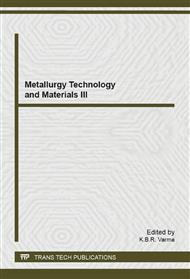[1]
J.K. Kim, G. Cheruvally, J. W. Choi, J. U. Kim, J. H. Ahn, G. B. Cho, K. W. Kim and H. J. Ahn: Journal of Power Sources Vol. 166(2007), p.211.
DOI: 10.1016/j.jpowsour.2006.12.089
Google Scholar
[2]
L. Wang, G.C. Liang, X.Q. Ou, X.K. Zhi, J.P. Zhang and J.Y. Cui: Journal of Power Sources Vol. 189(2009), p.423.
Google Scholar
[3]
K. Amine, J. Liu and I. Belharouak: Electrochem Commun Vol. 7(2005), p.669.
Google Scholar
[4]
M. Gaberscek, R. Dominko and J. Jamnik: Electrochem Commun Vol. 9(2007), p.2778.
Google Scholar
[5]
D. Zhang, R. Cai, Y. K. Zhou, Z. P. Shao, X. Z. Liao and Z. F. Ma: Electrochim Acta Vol. 55(2010), p.2653.
Google Scholar
[6]
W. J. Zhang: Journal of Power Sources Vol. 196(2011), p.2962.
Google Scholar
[7]
B. Zhao, Y. Jiang, H. J. Zhang, H. H. Tao, M. Y. Zhong and Z. Jiao: Journal of Power Sources Vol. 189(2009), p.462.
Google Scholar
[8]
Y. Liu, C. H. Mi, C. Z. Yua and X. G. Zhang: Journal of Electroanalytical Chemistry Vol. 628(2009), p.73.
Google Scholar
[9]
K. Zaghib, A. Mauger, F. Gendron and C. M. Jullen: Chemistry of Materials Vol. 20(2008), p.462.
Google Scholar
[10]
B. Boonchom and C. Danvirutai: Industrial & Engineering Chemistry Research Vol. 46(2007), p.9071.
Google Scholar
[11]
H. Huang, S. C. Yin and L. F. Nazar: Electrochemical and Solid-State Letters Vol. 4(2001), p. A170.
Google Scholar
[12]
K. F. Hsu, S. Y. Tsayas and B. J. Hwang: Journal of Materials Chemistry Vol. 14(2004), p.2690.
Google Scholar
[13]
Y. Wang, J. Wang, J. Yang and Y. Nuli: Advanced Functional Materials Vol. 16(2006), p.2135.
Google Scholar
[14]
A. F. Liu, Y. F. Liu, Z. H. Hu, G. Gao, Y. Y. Xu and L. Lei: Journal of Physics and Chemistry of SolidsVol. 72(2011), p.831.
Google Scholar
[15]
M. M. Doeff, Y. Hu, F. McLarnon and R. Kostecki. : Electrochemical and Solid-State Letters Vol. 6(2003), p. A207.
DOI: 10.1149/1.1601372
Google Scholar
[16]
Y. Q. Hu, M. M. Doeff, R. Kostecki and R. Finones. : Journal of The Electrochemical Society Vol. 151(2004), p. A1279.
Google Scholar
[17]
Y. Jin, C. P. Yang, X. H. Rui, T. Cheng, C. H. Chen: Journal of Power Sources Vol. 196(2011), p.5623.
Google Scholar
[18]
N. Ravet, Y. Chouinard, J. F. Magnan, S. Besner, M. Gauthier and M. Armand : Journal of Power Sources Vol. 97-98(2001), p.503.
DOI: 10.1016/s0378-7753(01)00727-3
Google Scholar
[19]
A. Yamada, S. C. Chunga and K. Hinokuma: Journal of The Electrochemical Society Vol. 148(2001), p. A224.
Google Scholar
[20]
Y. D. Cho, G. D. K. Fey and H. M. Kao: Journal of Power Sources Vol. 189(2009), p.256.
Google Scholar


